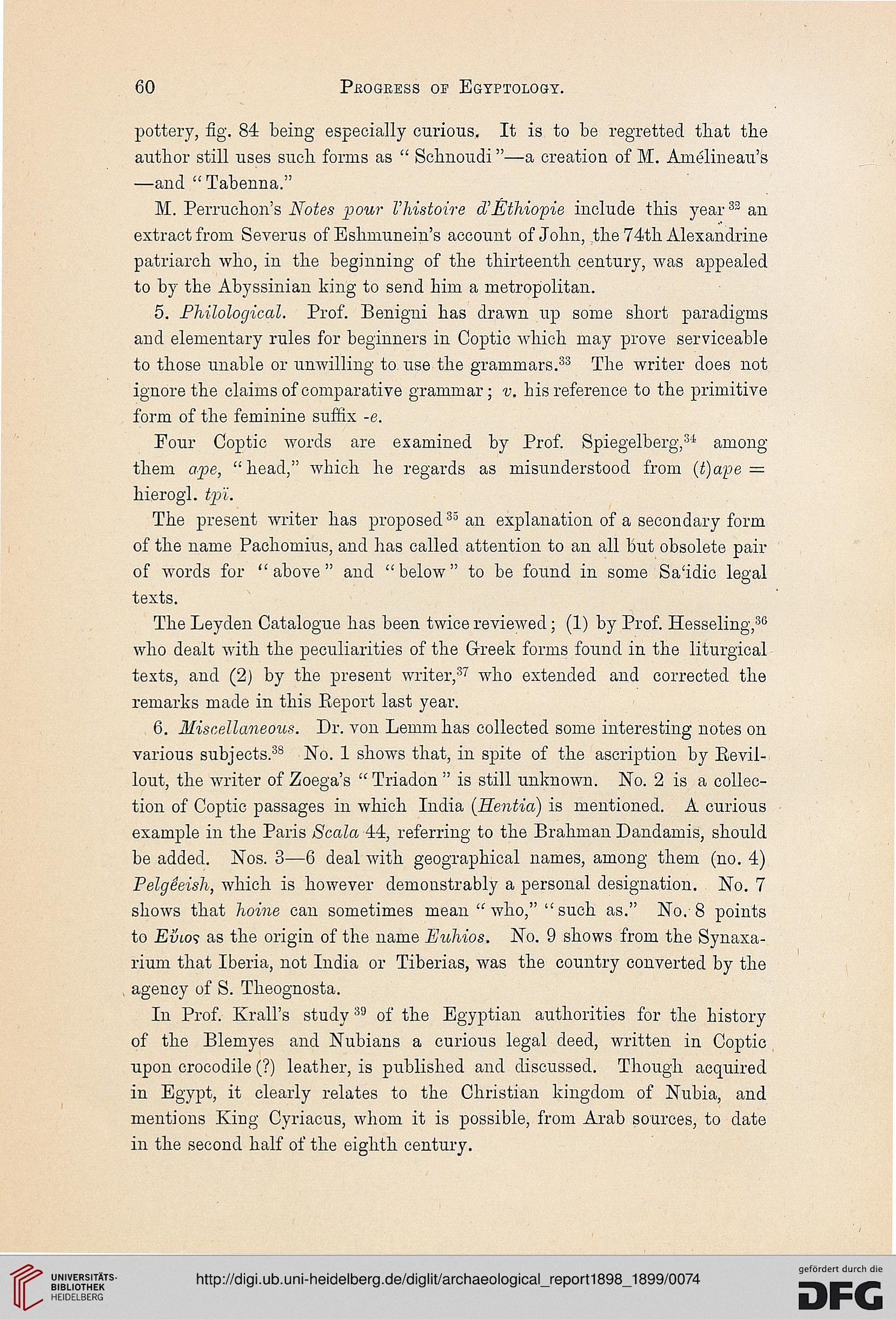60
Peogeess of Egyptology.
pottery, fig. 84 being especially curious. It is to be regretted that the
author still uses such forms as " Schnoudi"—a creation of M. Amelineau's
—and " Tabenna."
M. Perruchon's Notes pour Vhistoire d'Ethiopie include this year33 an
extract from Severus of Eshmunein's account of John, the 74th Alexandrine
patriarch who, in the beginning of the thirteenth century, was appealed
to by the Abyssinian king to send him a metropolitan.
5. Philological. Prof. Benigni has drawn up some short paradigms
and elementary rules for beginners in Coptic which may prove serviceable
to those unable or unwilling to use the grammars.33 The writer does not
ignore the claims of comparative grammar; v. his reference to the primitive
form of the feminine suffix -e.
Four Coptic words are examined by Prof. Spiegelberg,3' among
them ape, "head," which he regards as misunderstood from (t)ape -
hierogl. tp'i.
The present writer has proposed33 an explanation of a secondary form
of the name Pachomius, and has called attention to an all but obsolete pair
of words for " above " and " below" to be found in some Sa'idic legal
texts.
The Leyden Catalogue has been twice reviewed; (1) by Prof. Hesseling,30
who dealt with the peculiarities of the Greek forms found in the liturgical
texts, and (2) by the present writer,37 who extended and corrected the
remarks made in this Eeport last year.
6. Miscellaneous. Dr. von Lemm has collected some interesting notes on
various subjects.38 No. 1 shows that, in spite of the ascription by Eevil-
lout, the writer of Zoega's " Triadon " is still unknown. No. 2 is a collec-
tion of Coptic passages in which India (Hentia) is mentioned. A curious
example in the Paris Scala 44, referring to the Brahman Dandamis, should
be added. Nos. 3—6 deal with geographical names, among them (no. 4)
Pelgeeish, which is however demonstrably a personal designation. No. 7
shows that hoine can sometimes mean " who," " such as." No. 8 points
to Euto? as the origin of the name Euhios, No. 9 shows from the Synaxa-
rium that Iberia, not India or Tiberias, was the country converted by the
agency of S. Theognosta.
In Prof. Krall's study39 of the Egyptian authorities for the history
of the Blemyes and Nubians a curious legal deed, written in Coptic
upon crocodile (?) leather, is published and discussed. Though acquired
in Egypt, it clearly relates to the Christian kingdom of Nubia, and
mentions King Cyriacus, whom it is possible, from Arab sources, to date
in the second half of the eighth century.
Peogeess of Egyptology.
pottery, fig. 84 being especially curious. It is to be regretted that the
author still uses such forms as " Schnoudi"—a creation of M. Amelineau's
—and " Tabenna."
M. Perruchon's Notes pour Vhistoire d'Ethiopie include this year33 an
extract from Severus of Eshmunein's account of John, the 74th Alexandrine
patriarch who, in the beginning of the thirteenth century, was appealed
to by the Abyssinian king to send him a metropolitan.
5. Philological. Prof. Benigni has drawn up some short paradigms
and elementary rules for beginners in Coptic which may prove serviceable
to those unable or unwilling to use the grammars.33 The writer does not
ignore the claims of comparative grammar; v. his reference to the primitive
form of the feminine suffix -e.
Four Coptic words are examined by Prof. Spiegelberg,3' among
them ape, "head," which he regards as misunderstood from (t)ape -
hierogl. tp'i.
The present writer has proposed33 an explanation of a secondary form
of the name Pachomius, and has called attention to an all but obsolete pair
of words for " above " and " below" to be found in some Sa'idic legal
texts.
The Leyden Catalogue has been twice reviewed; (1) by Prof. Hesseling,30
who dealt with the peculiarities of the Greek forms found in the liturgical
texts, and (2) by the present writer,37 who extended and corrected the
remarks made in this Eeport last year.
6. Miscellaneous. Dr. von Lemm has collected some interesting notes on
various subjects.38 No. 1 shows that, in spite of the ascription by Eevil-
lout, the writer of Zoega's " Triadon " is still unknown. No. 2 is a collec-
tion of Coptic passages in which India (Hentia) is mentioned. A curious
example in the Paris Scala 44, referring to the Brahman Dandamis, should
be added. Nos. 3—6 deal with geographical names, among them (no. 4)
Pelgeeish, which is however demonstrably a personal designation. No. 7
shows that hoine can sometimes mean " who," " such as." No. 8 points
to Euto? as the origin of the name Euhios, No. 9 shows from the Synaxa-
rium that Iberia, not India or Tiberias, was the country converted by the
agency of S. Theognosta.
In Prof. Krall's study39 of the Egyptian authorities for the history
of the Blemyes and Nubians a curious legal deed, written in Coptic
upon crocodile (?) leather, is published and discussed. Though acquired
in Egypt, it clearly relates to the Christian kingdom of Nubia, and
mentions King Cyriacus, whom it is possible, from Arab sources, to date
in the second half of the eighth century.





